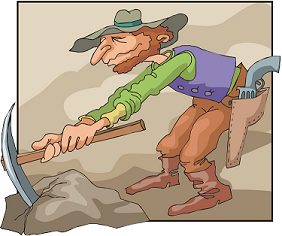Students will learn about various gold rushes, including the California, Colorado, and Alaska Gold Rushes.
Teaching Objectives:
- Students will understand of the major events surrounding the California, Colorado, and Alaska Gold Rushes.
- Students will understand the impact of the Gold Rushes on western expansion in the U.S.
- Students will understand many important issues surrounding U.S. territorial expansion.
Suggested Grade Level
6th – 8th Grade
Related Standards (from McREL’s Standards Compendium) :
- S. History Standard 9: Understands the United States territorial expansion between 1801 and 1861, and how it affected relations with external powers and Native Americans
- S. History Standard 10: Understands how the industrial revolution, increasing immigration, the rapid expansion of slavery, and the westward movement changed American lives and led to regional tensions
- Language Arts Standards 4: Gathers and uses information for research purposes
- Language Arts Standards 7: Uses reading skills and strategies to understand and interpret a variety of informational texts
Overview of Lesson:
- Students read about of the California, Colorado, and Alaska Gold Rushes using either their textbooks or the information provided here.
- Students complete the chart comparing the three Gold Rushes.
- Students work in small groups to conduct further research on one of the three Gold Rushes and create a report and visual aid to demonstrate their research.
Time Needed for Lesson:
1 class period for reading, discussion, and completion of chart. The report and visual aid will require another 3-5 class periods.
Major Points of Emphasis
- Gold is a precious metal which has been used for thousands of years as a source of currency and wealth.
- Although a frenzy accompanied each of the three Gold Rushes discussed here, they did much to open up Western territories to settlement and development.
- As prospectors hurried to find gold, they created a need for more goods and services in the West, causing many others to follow their lead and leading to the rapid development of many regions of the country.
- The prospectors endured many hardships along the way.
- The Gold Rushes caused changes to the geography of the regions they took place in and affected the Native American populations already present on the lands.
Lesson Excerpt:
Gold was first discovered in Northern California, very close to the city of San Francisco. The actual location of the discovery was Sutter’s Mill at a place where the American and Sacramento Rivers come together near the Sierra Nevada mountain range. James Marshall, who had been hired by John Sutter to build a sawmill on his land, was the first to find a golden nugget on January 28, 1848. After testing it, he learned that it was indeed real gold. Although he only told a few people because he wanted to keep his finding a secret, this was not to be.
Throughout 1848 the news spread, at first locally, and then throughout the state, the country, and the world. The news started a frenzy in which people madly rushed to California to search for gold and instant wealth. Throughout 1849, people came from all over to search for gold, often traveling thousands of miles and facing terrible hardships along the way. The “49ers,” as they were called, came by land and by sea; both U.S. citizens and immigrants came in search of wealth and opportunity. By the time that the majority of the prospectors had arrived, however, they found that most of the gold had already been taken.